Infection Control Practices in Healthcare
VerifiedAdded on 2020/05/28
|16
|5916
|533
AI Summary
This assignment assesses a student's knowledge of infection control practices in healthcare. It requires the student to identify situations where standard precautions are insufficient, propose additional control measures, report infection risks, and evaluate the use of precautions in various scenarios. The assessment includes multiple-choice questions, short answer tasks, and scenarios requiring critical thinking about safety procedures.
Contribute Materials
Your contribution can guide someone’s learning journey. Share your
documents today.
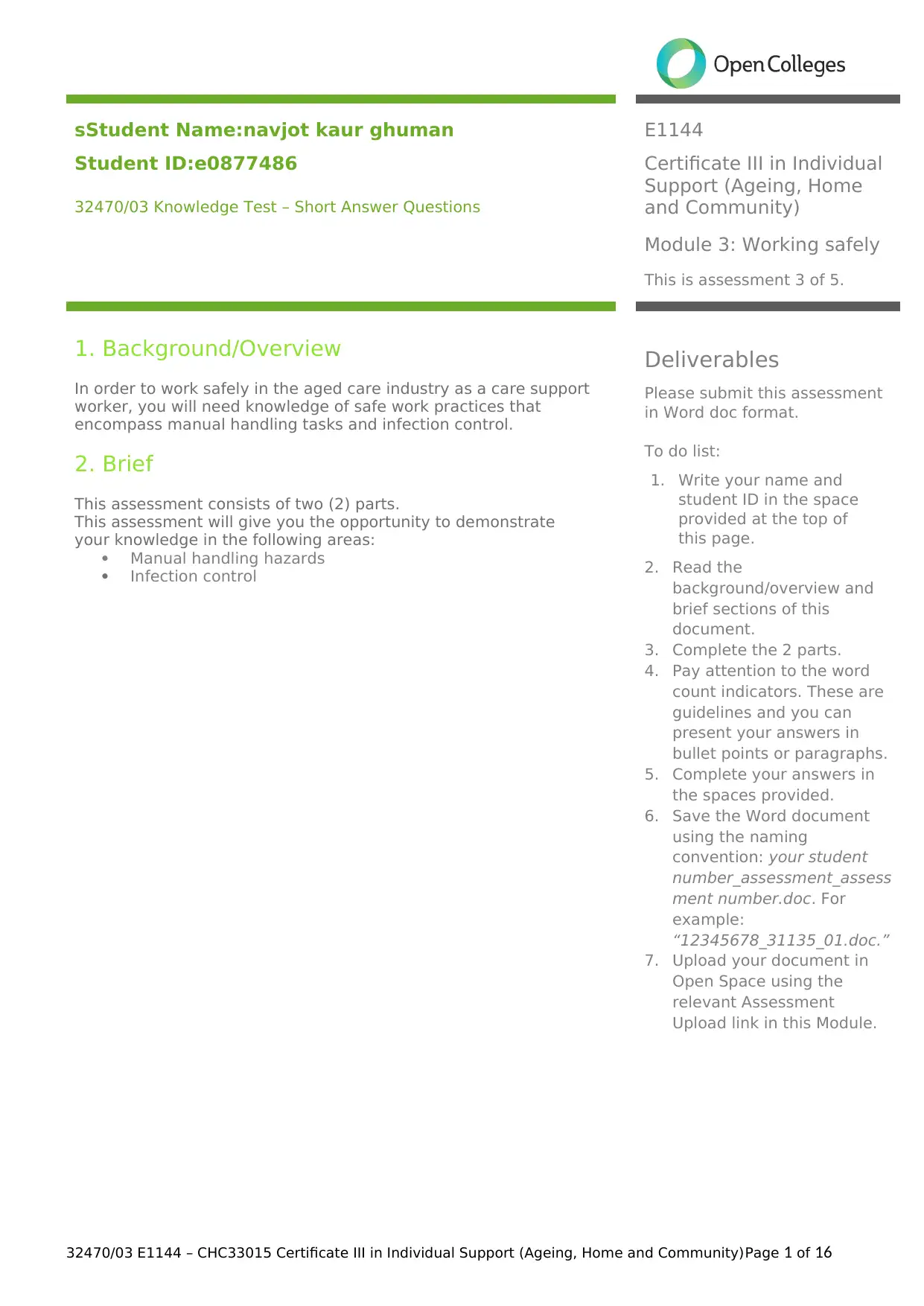
sStudent Name:navjot kaur ghuman
Student ID:e0877486
32470/03 Knowledge Test – Short Answer Questions
E1144
Certificate III in Individual
Support (Ageing, Home
and Community)
Module 3: Working safely
This is assessment 3 of 5.
1. Background/Overview
In order to work safely in the aged care industry as a care support
worker, you will need knowledge of safe work practices that
encompass manual handling tasks and infection control.
2. Brief
This assessment consists of two (2) parts.
This assessment will give you the opportunity to demonstrate
your knowledge in the following areas:
Manual handling hazards
Infection control
Deliverables
Please submit this assessment
in Word doc format.
To do list:
1. Write your name and
student ID in the space
provided at the top of
this page.
2. Read the
background/overview and
brief sections of this
document.
3. Complete the 2 parts.
4. Pay attention to the word
count indicators. These are
guidelines and you can
present your answers in
bullet points or paragraphs.
5. Complete your answers in
the spaces provided.
6. Save the Word document
using the naming
convention: your student
number_assessment_assess
ment number.doc. For
example:
“12345678_31135_01.doc.”
7. Upload your document in
Open Space using the
relevant Assessment
Upload link in this Module.
32470/03 E1144 – CHC33015 Certificate III in Individual Support (Ageing, Home and Community)Page 1 of 16
Student ID:e0877486
32470/03 Knowledge Test – Short Answer Questions
E1144
Certificate III in Individual
Support (Ageing, Home
and Community)
Module 3: Working safely
This is assessment 3 of 5.
1. Background/Overview
In order to work safely in the aged care industry as a care support
worker, you will need knowledge of safe work practices that
encompass manual handling tasks and infection control.
2. Brief
This assessment consists of two (2) parts.
This assessment will give you the opportunity to demonstrate
your knowledge in the following areas:
Manual handling hazards
Infection control
Deliverables
Please submit this assessment
in Word doc format.
To do list:
1. Write your name and
student ID in the space
provided at the top of
this page.
2. Read the
background/overview and
brief sections of this
document.
3. Complete the 2 parts.
4. Pay attention to the word
count indicators. These are
guidelines and you can
present your answers in
bullet points or paragraphs.
5. Complete your answers in
the spaces provided.
6. Save the Word document
using the naming
convention: your student
number_assessment_assess
ment number.doc. For
example:
“12345678_31135_01.doc.”
7. Upload your document in
Open Space using the
relevant Assessment
Upload link in this Module.
32470/03 E1144 – CHC33015 Certificate III in Individual Support (Ageing, Home and Community)Page 1 of 16
Secure Best Marks with AI Grader
Need help grading? Try our AI Grader for instant feedback on your assignments.
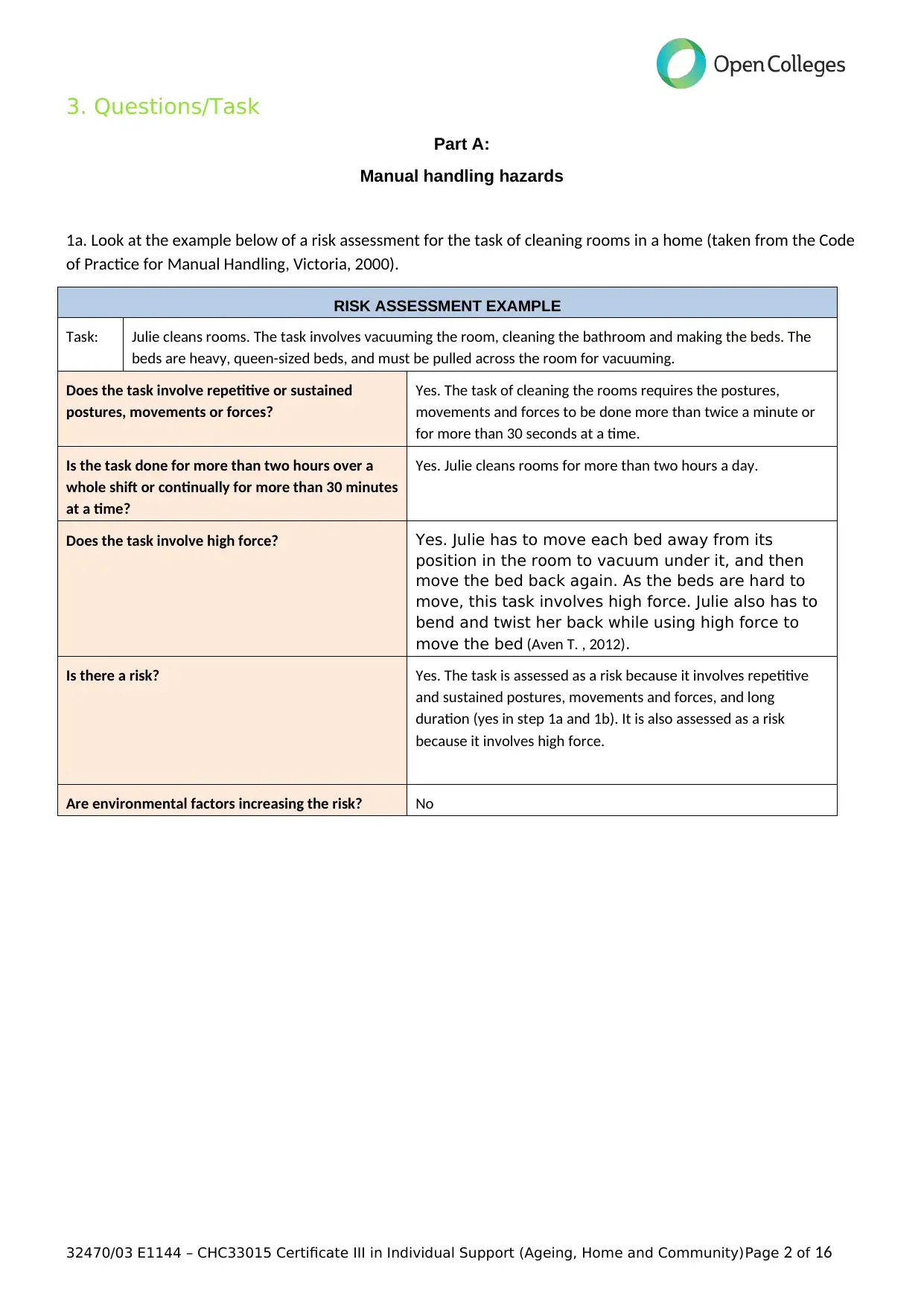
3. Questions/Task
Part A:
Manual handling hazards
1a. Look at the example below of a risk assessment for the task of cleaning rooms in a home (taken from the Code
of Practice for Manual Handling, Victoria, 2000).
RISK ASSESSMENT EXAMPLE
Task: Julie cleans rooms. The task involves vacuuming the room, cleaning the bathroom and making the beds. The
beds are heavy, queen-sized beds, and must be pulled across the room for vacuuming.
Does the task involve repetitive or sustained
postures, movements or forces?
Yes. The task of cleaning the rooms requires the postures,
movements and forces to be done more than twice a minute or
for more than 30 seconds at a time.
Is the task done for more than two hours over a
whole shift or continually for more than 30 minutes
at a time?
Yes. Julie cleans rooms for more than two hours a day.
Does the task involve high force? Yes. Julie has to move each bed away from its
position in the room to vacuum under it, and then
move the bed back again. As the beds are hard to
move, this task involves high force. Julie also has to
bend and twist her back while using high force to
move the bed (Aven T. , 2012).
Is there a risk? Yes. The task is assessed as a risk because it involves repetitive
and sustained postures, movements and forces, and long
duration (yes in step 1a and 1b). It is also assessed as a risk
because it involves high force.
Are environmental factors increasing the risk? No
32470/03 E1144 – CHC33015 Certificate III in Individual Support (Ageing, Home and Community)Page 2 of 16
Part A:
Manual handling hazards
1a. Look at the example below of a risk assessment for the task of cleaning rooms in a home (taken from the Code
of Practice for Manual Handling, Victoria, 2000).
RISK ASSESSMENT EXAMPLE
Task: Julie cleans rooms. The task involves vacuuming the room, cleaning the bathroom and making the beds. The
beds are heavy, queen-sized beds, and must be pulled across the room for vacuuming.
Does the task involve repetitive or sustained
postures, movements or forces?
Yes. The task of cleaning the rooms requires the postures,
movements and forces to be done more than twice a minute or
for more than 30 seconds at a time.
Is the task done for more than two hours over a
whole shift or continually for more than 30 minutes
at a time?
Yes. Julie cleans rooms for more than two hours a day.
Does the task involve high force? Yes. Julie has to move each bed away from its
position in the room to vacuum under it, and then
move the bed back again. As the beds are hard to
move, this task involves high force. Julie also has to
bend and twist her back while using high force to
move the bed (Aven T. , 2012).
Is there a risk? Yes. The task is assessed as a risk because it involves repetitive
and sustained postures, movements and forces, and long
duration (yes in step 1a and 1b). It is also assessed as a risk
because it involves high force.
Are environmental factors increasing the risk? No
32470/03 E1144 – CHC33015 Certificate III in Individual Support (Ageing, Home and Community)Page 2 of 16
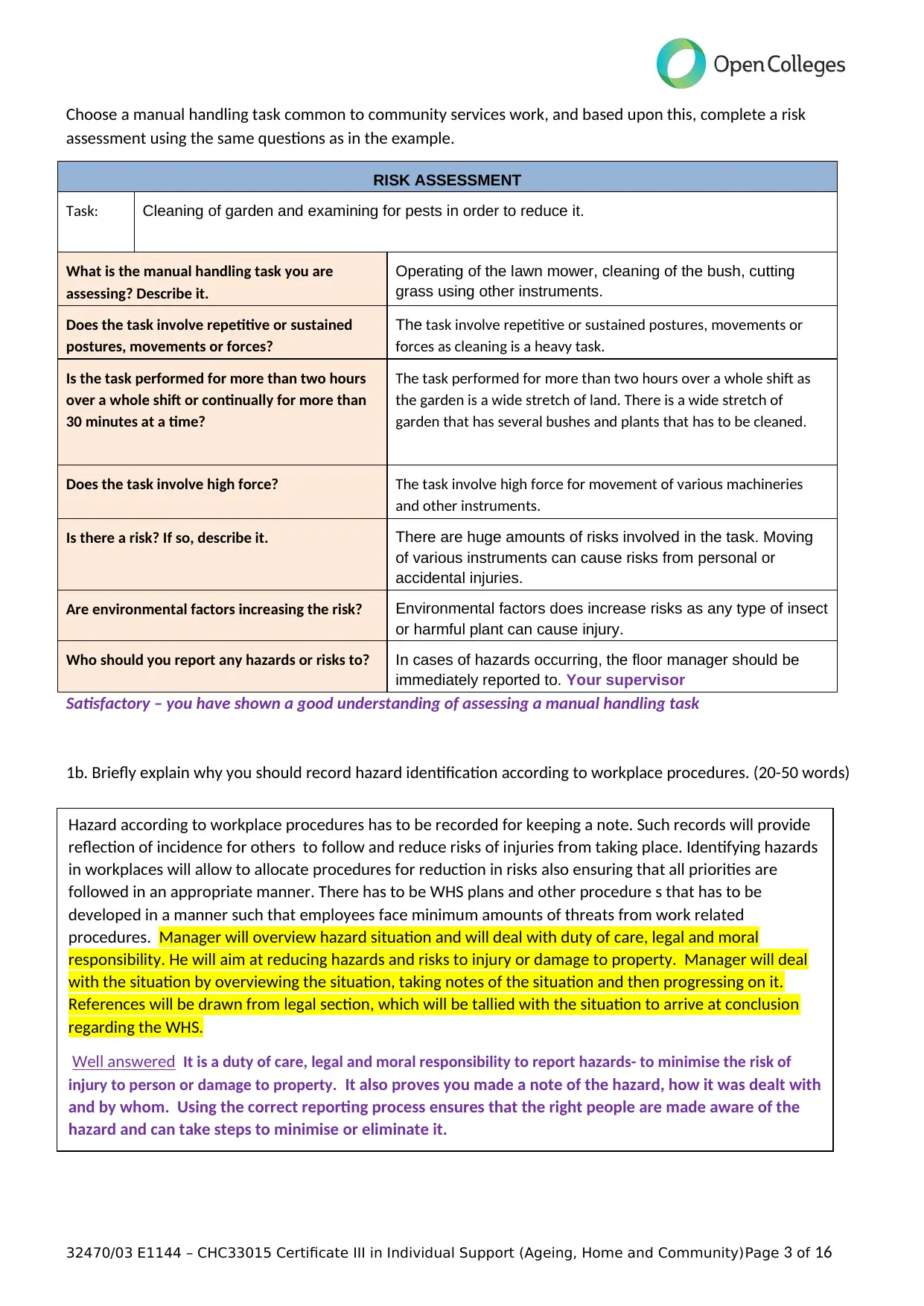
Choose a manual handling task common to community services work, and based upon this, complete a risk
assessment using the same questions as in the example.
RISK ASSESSMENT
Task: Cleaning of garden and examining for pests in order to reduce it.
What is the manual handling task you are
assessing? Describe it.
Operating of the lawn mower, cleaning of the bush, cutting
grass using other instruments.
Does the task involve repetitive or sustained
postures, movements or forces?
The task involve repetitive or sustained postures, movements or
forces as cleaning is a heavy task.
Is the task performed for more than two hours
over a whole shift or continually for more than
30 minutes at a time?
The task performed for more than two hours over a whole shift as
the garden is a wide stretch of land. There is a wide stretch of
garden that has several bushes and plants that has to be cleaned.
Does the task involve high force? The task involve high force for movement of various machineries
and other instruments.
Is there a risk? If so, describe it. There are huge amounts of risks involved in the task. Moving
of various instruments can cause risks from personal or
accidental injuries.
Are environmental factors increasing the risk? Environmental factors does increase risks as any type of insect
or harmful plant can cause injury.
Who should you report any hazards or risks to? In cases of hazards occurring, the floor manager should be
immediately reported to. Your supervisor
Satisfactory – you have shown a good understanding of assessing a manual handling task
1b. Briefly explain why you should record hazard identification according to workplace procedures. (20-50 words)
32470/03 E1144 – CHC33015 Certificate III in Individual Support (Ageing, Home and Community)Page 3 of 16
Hazard according to workplace procedures has to be recorded for keeping a note. Such records will provide
reflection of incidence for others to follow and reduce risks of injuries from taking place. Identifying hazards
in workplaces will allow to allocate procedures for reduction in risks also ensuring that all priorities are
followed in an appropriate manner. There has to be WHS plans and other procedure s that has to be
developed in a manner such that employees face minimum amounts of threats from work related
procedures. Manager will overview hazard situation and will deal with duty of care, legal and moral
responsibility. He will aim at reducing hazards and risks to injury or damage to property. Manager will deal
with the situation by overviewing the situation, taking notes of the situation and then progressing on it.
References will be drawn from legal section, which will be tallied with the situation to arrive at conclusion
regarding the WHS.
Well answered It is a duty of care, legal and moral responsibility to report hazards- to minimise the risk of
injury to person or damage to property. It also proves you made a note of the hazard, how it was dealt with
and by whom. Using the correct reporting process ensures that the right people are made aware of the
hazard and can take steps to minimise or eliminate it.
assessment using the same questions as in the example.
RISK ASSESSMENT
Task: Cleaning of garden and examining for pests in order to reduce it.
What is the manual handling task you are
assessing? Describe it.
Operating of the lawn mower, cleaning of the bush, cutting
grass using other instruments.
Does the task involve repetitive or sustained
postures, movements or forces?
The task involve repetitive or sustained postures, movements or
forces as cleaning is a heavy task.
Is the task performed for more than two hours
over a whole shift or continually for more than
30 minutes at a time?
The task performed for more than two hours over a whole shift as
the garden is a wide stretch of land. There is a wide stretch of
garden that has several bushes and plants that has to be cleaned.
Does the task involve high force? The task involve high force for movement of various machineries
and other instruments.
Is there a risk? If so, describe it. There are huge amounts of risks involved in the task. Moving
of various instruments can cause risks from personal or
accidental injuries.
Are environmental factors increasing the risk? Environmental factors does increase risks as any type of insect
or harmful plant can cause injury.
Who should you report any hazards or risks to? In cases of hazards occurring, the floor manager should be
immediately reported to. Your supervisor
Satisfactory – you have shown a good understanding of assessing a manual handling task
1b. Briefly explain why you should record hazard identification according to workplace procedures. (20-50 words)
32470/03 E1144 – CHC33015 Certificate III in Individual Support (Ageing, Home and Community)Page 3 of 16
Hazard according to workplace procedures has to be recorded for keeping a note. Such records will provide
reflection of incidence for others to follow and reduce risks of injuries from taking place. Identifying hazards
in workplaces will allow to allocate procedures for reduction in risks also ensuring that all priorities are
followed in an appropriate manner. There has to be WHS plans and other procedure s that has to be
developed in a manner such that employees face minimum amounts of threats from work related
procedures. Manager will overview hazard situation and will deal with duty of care, legal and moral
responsibility. He will aim at reducing hazards and risks to injury or damage to property. Manager will deal
with the situation by overviewing the situation, taking notes of the situation and then progressing on it.
References will be drawn from legal section, which will be tallied with the situation to arrive at conclusion
regarding the WHS.
Well answered It is a duty of care, legal and moral responsibility to report hazards- to minimise the risk of
injury to person or damage to property. It also proves you made a note of the hazard, how it was dealt with
and by whom. Using the correct reporting process ensures that the right people are made aware of the
hazard and can take steps to minimise or eliminate it.
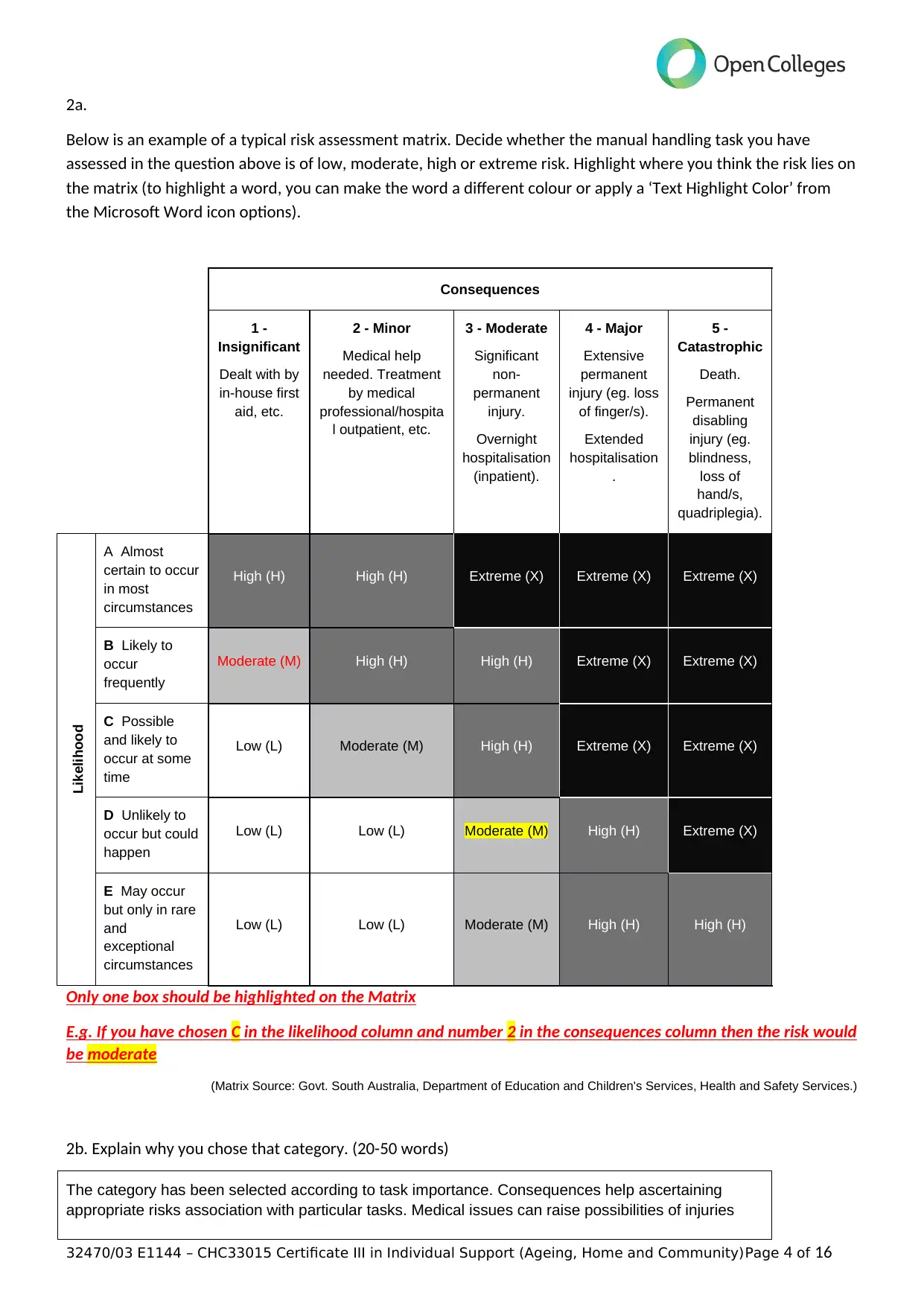
2a.
Below is an example of a typical risk assessment matrix. Decide whether the manual handling task you have
assessed in the question above is of low, moderate, high or extreme risk. Highlight where you think the risk lies on
the matrix (to highlight a word, you can make the word a different colour or apply a ‘Text Highlight Color’ from
the Microsoft Word icon options).
Consequences
1 -
Insignificant
Dealt with by
in-house first
aid, etc.
2 - Minor
Medical help
needed. Treatment
by medical
professional/hospita
l outpatient, etc.
3 - Moderate
Significant
non-
permanent
injury.
Overnight
hospitalisation
(inpatient).
4 - Major
Extensive
permanent
injury (eg. loss
of finger/s).
Extended
hospitalisation
.
5 -
Catastrophic
Death.
Permanent
disabling
injury (eg.
blindness,
loss of
hand/s,
quadriplegia).
Likelihood
A Almost
certain to occur
in most
circumstances
High (H) High (H) Extreme (X) Extreme (X) Extreme (X)
B Likely to
occur
frequently
Moderate (M) High (H) High (H) Extreme (X) Extreme (X)
C Possible
and likely to
occur at some
time
Low (L) Moderate (M) High (H) Extreme (X) Extreme (X)
D Unlikely to
occur but could
happen
Low (L) Low (L) Moderate (M) High (H) Extreme (X)
E May occur
but only in rare
and
exceptional
circumstances
Low (L) Low (L) Moderate (M) High (H) High (H)
Only one box should be highlighted on the Matrix
E.g. If you have chosen C in the likelihood column and number 2 in the consequences column then the risk would
be moderate
(Matrix Source: Govt. South Australia, Department of Education and Children's Services, Health and Safety Services.)
2b. Explain why you chose that category. (20-50 words)
The category has been selected according to task importance. Consequences help ascertaining
appropriate risks association with particular tasks. Medical issues can raise possibilities of injuries
32470/03 E1144 – CHC33015 Certificate III in Individual Support (Ageing, Home and Community)Page 4 of 16
Below is an example of a typical risk assessment matrix. Decide whether the manual handling task you have
assessed in the question above is of low, moderate, high or extreme risk. Highlight where you think the risk lies on
the matrix (to highlight a word, you can make the word a different colour or apply a ‘Text Highlight Color’ from
the Microsoft Word icon options).
Consequences
1 -
Insignificant
Dealt with by
in-house first
aid, etc.
2 - Minor
Medical help
needed. Treatment
by medical
professional/hospita
l outpatient, etc.
3 - Moderate
Significant
non-
permanent
injury.
Overnight
hospitalisation
(inpatient).
4 - Major
Extensive
permanent
injury (eg. loss
of finger/s).
Extended
hospitalisation
.
5 -
Catastrophic
Death.
Permanent
disabling
injury (eg.
blindness,
loss of
hand/s,
quadriplegia).
Likelihood
A Almost
certain to occur
in most
circumstances
High (H) High (H) Extreme (X) Extreme (X) Extreme (X)
B Likely to
occur
frequently
Moderate (M) High (H) High (H) Extreme (X) Extreme (X)
C Possible
and likely to
occur at some
time
Low (L) Moderate (M) High (H) Extreme (X) Extreme (X)
D Unlikely to
occur but could
happen
Low (L) Low (L) Moderate (M) High (H) Extreme (X)
E May occur
but only in rare
and
exceptional
circumstances
Low (L) Low (L) Moderate (M) High (H) High (H)
Only one box should be highlighted on the Matrix
E.g. If you have chosen C in the likelihood column and number 2 in the consequences column then the risk would
be moderate
(Matrix Source: Govt. South Australia, Department of Education and Children's Services, Health and Safety Services.)
2b. Explain why you chose that category. (20-50 words)
The category has been selected according to task importance. Consequences help ascertaining
appropriate risks association with particular tasks. Medical issues can raise possibilities of injuries
32470/03 E1144 – CHC33015 Certificate III in Individual Support (Ageing, Home and Community)Page 4 of 16
Secure Best Marks with AI Grader
Need help grading? Try our AI Grader for instant feedback on your assignments.
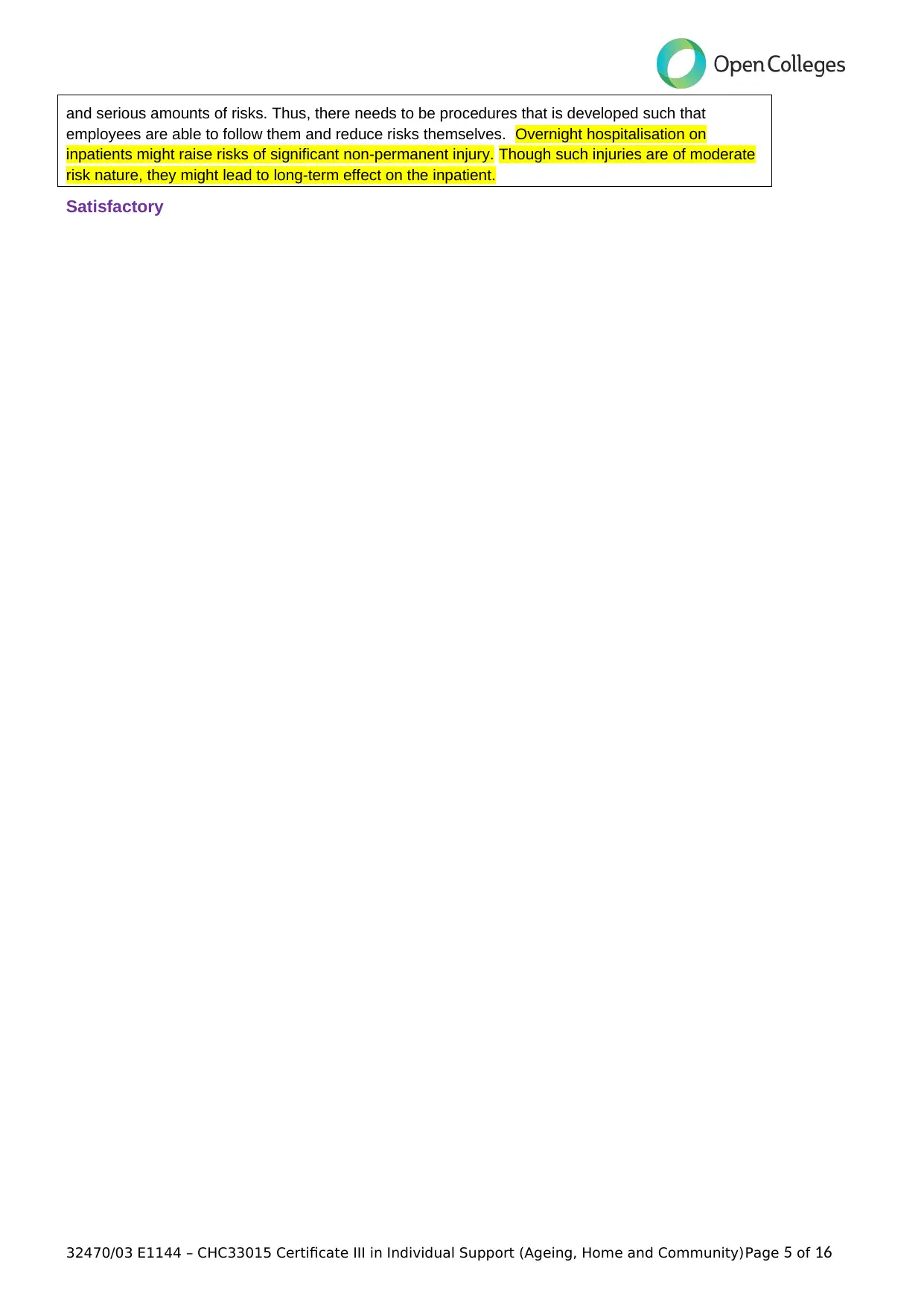
and serious amounts of risks. Thus, there needs to be procedures that is developed such that
employees are able to follow them and reduce risks themselves. Overnight hospitalisation on
inpatients might raise risks of significant non-permanent injury. Though such injuries are of moderate
risk nature, they might lead to long-term effect on the inpatient.
Satisfactory
32470/03 E1144 – CHC33015 Certificate III in Individual Support (Ageing, Home and Community)Page 5 of 16
employees are able to follow them and reduce risks themselves. Overnight hospitalisation on
inpatients might raise risks of significant non-permanent injury. Though such injuries are of moderate
risk nature, they might lead to long-term effect on the inpatient.
Satisfactory
32470/03 E1144 – CHC33015 Certificate III in Individual Support (Ageing, Home and Community)Page 5 of 16
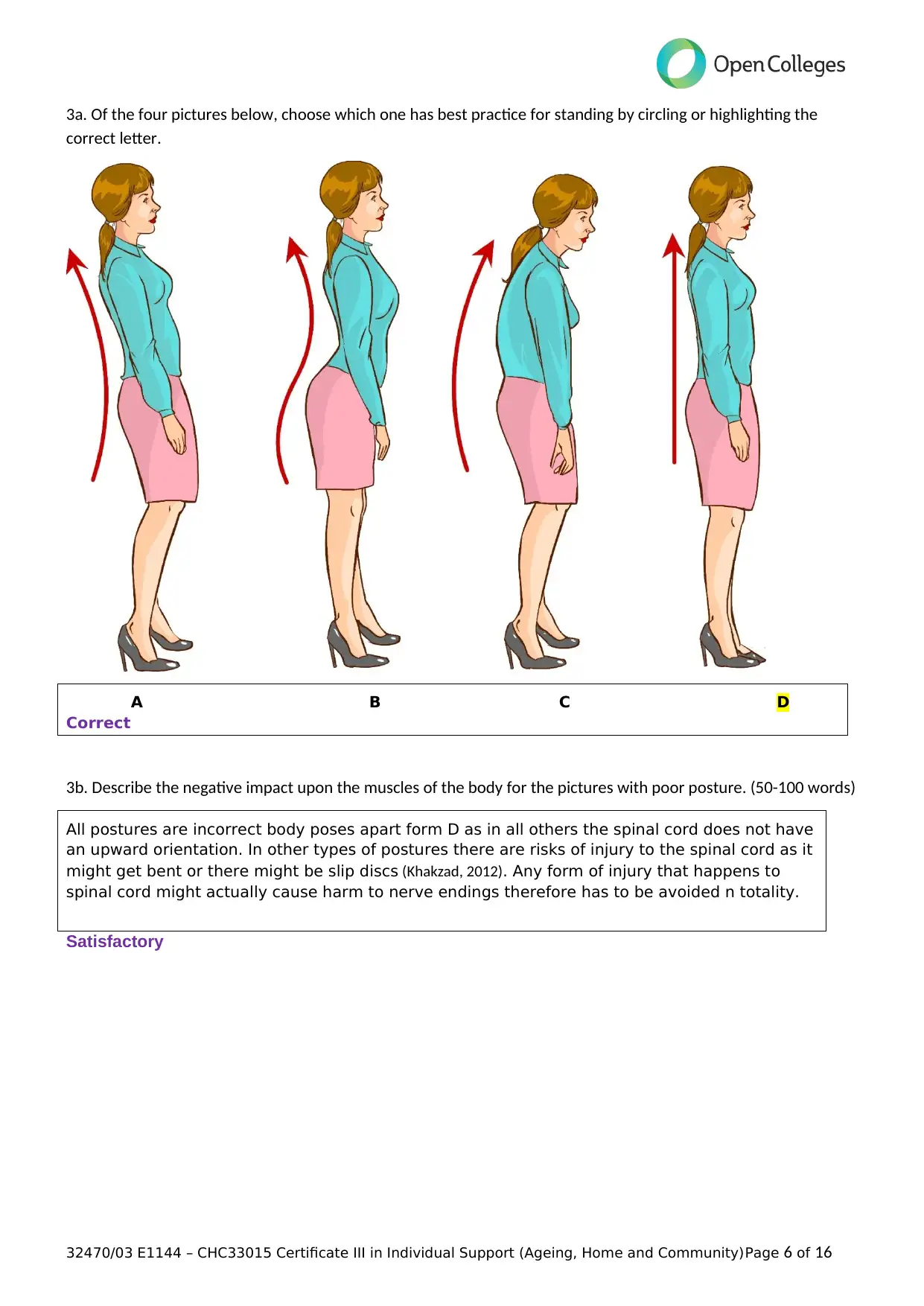
3a. Of the four pictures below, choose which one has best practice for standing by circling or highlighting the
correct letter.
A B C D
Correct
3b. Describe the negative impact upon the muscles of the body for the pictures with poor posture. (50-100 words)
All postures are incorrect body poses apart form D as in all others the spinal cord does not have
an upward orientation. In other types of postures there are risks of injury to the spinal cord as it
might get bent or there might be slip discs (Khakzad, 2012). Any form of injury that happens to
spinal cord might actually cause harm to nerve endings therefore has to be avoided n totality.
Satisfactory
32470/03 E1144 – CHC33015 Certificate III in Individual Support (Ageing, Home and Community)Page 6 of 16
correct letter.
A B C D
Correct
3b. Describe the negative impact upon the muscles of the body for the pictures with poor posture. (50-100 words)
All postures are incorrect body poses apart form D as in all others the spinal cord does not have
an upward orientation. In other types of postures there are risks of injury to the spinal cord as it
might get bent or there might be slip discs (Khakzad, 2012). Any form of injury that happens to
spinal cord might actually cause harm to nerve endings therefore has to be avoided n totality.
Satisfactory
32470/03 E1144 – CHC33015 Certificate III in Individual Support (Ageing, Home and Community)Page 6 of 16
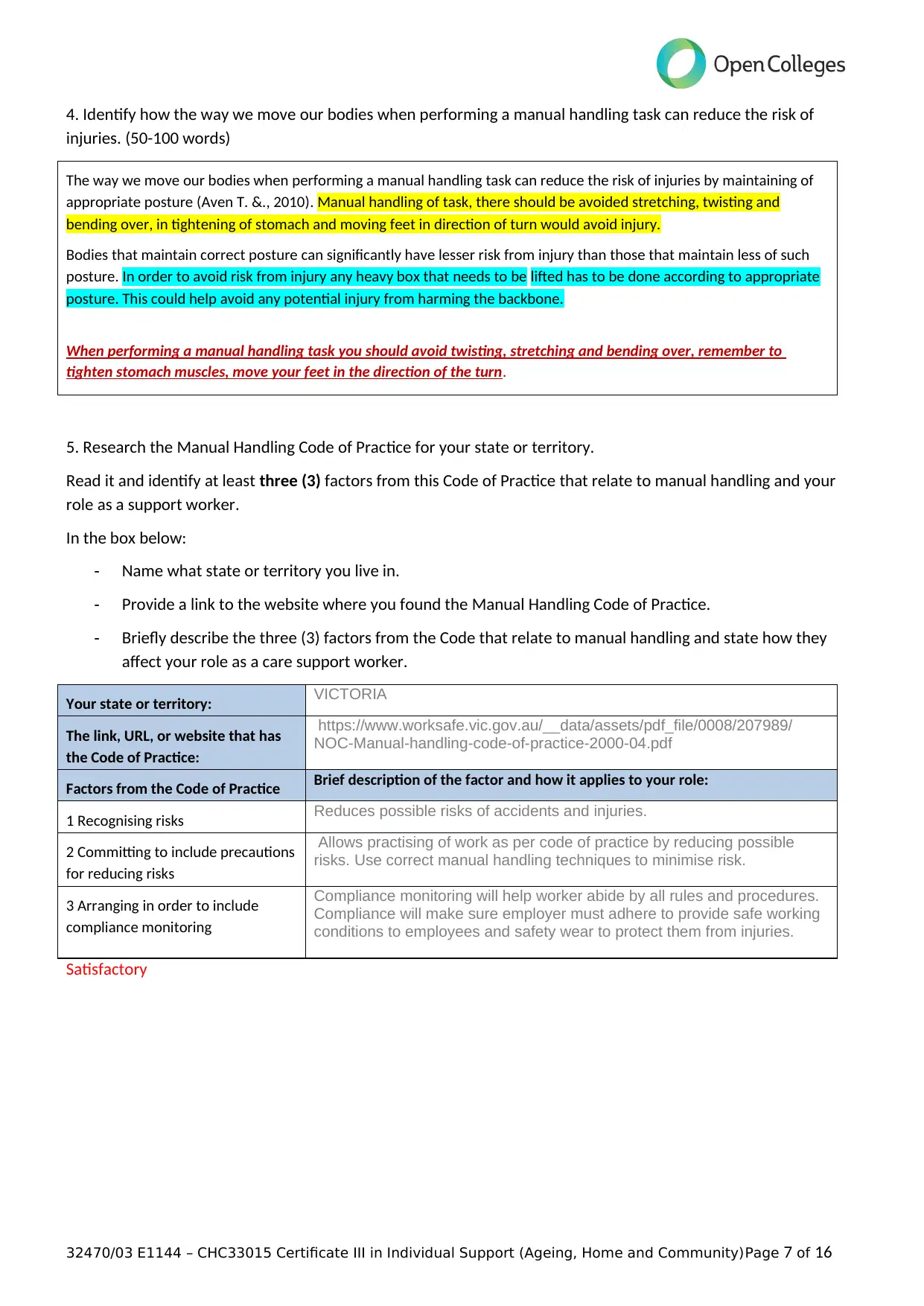
4. Identify how the way we move our bodies when performing a manual handling task can reduce the risk of
injuries. (50-100 words)
The way we move our bodies when performing a manual handling task can reduce the risk of injuries by maintaining of
appropriate posture (Aven T. &., 2010). Manual handling of task, there should be avoided stretching, twisting and
bending over, in tightening of stomach and moving feet in direction of turn would avoid injury.
Bodies that maintain correct posture can significantly have lesser risk from injury than those that maintain less of such
posture. In order to avoid risk from injury any heavy box that needs to be lifted has to be done according to appropriate
posture. This could help avoid any potential injury from harming the backbone.
When performing a manual handling task you should avoid twisting, stretching and bending over, remember to
tighten stomach muscles, move your feet in the direction of the turn.
5. Research the Manual Handling Code of Practice for your state or territory.
Read it and identify at least three (3) factors from this Code of Practice that relate to manual handling and your
role as a support worker.
In the box below:
- Name what state or territory you live in.
- Provide a link to the website where you found the Manual Handling Code of Practice.
- Briefly describe the three (3) factors from the Code that relate to manual handling and state how they
affect your role as a care support worker.
Your state or territory: VICTORIA
The link, URL, or website that has
the Code of Practice:
https://www.worksafe.vic.gov.au/__data/assets/pdf_file/0008/207989/
NOC-Manual-handling-code-of-practice-2000-04.pdf
Factors from the Code of Practice Brief description of the factor and how it applies to your role:
1 Recognising risks Reduces possible risks of accidents and injuries.
2 Committing to include precautions
for reducing risks
Allows practising of work as per code of practice by reducing possible
risks. Use correct manual handling techniques to minimise risk.
3 Arranging in order to include
compliance monitoring
Compliance monitoring will help worker abide by all rules and procedures.
Compliance will make sure employer must adhere to provide safe working
conditions to employees and safety wear to protect them from injuries.
Satisfactory
32470/03 E1144 – CHC33015 Certificate III in Individual Support (Ageing, Home and Community)Page 7 of 16
injuries. (50-100 words)
The way we move our bodies when performing a manual handling task can reduce the risk of injuries by maintaining of
appropriate posture (Aven T. &., 2010). Manual handling of task, there should be avoided stretching, twisting and
bending over, in tightening of stomach and moving feet in direction of turn would avoid injury.
Bodies that maintain correct posture can significantly have lesser risk from injury than those that maintain less of such
posture. In order to avoid risk from injury any heavy box that needs to be lifted has to be done according to appropriate
posture. This could help avoid any potential injury from harming the backbone.
When performing a manual handling task you should avoid twisting, stretching and bending over, remember to
tighten stomach muscles, move your feet in the direction of the turn.
5. Research the Manual Handling Code of Practice for your state or territory.
Read it and identify at least three (3) factors from this Code of Practice that relate to manual handling and your
role as a support worker.
In the box below:
- Name what state or territory you live in.
- Provide a link to the website where you found the Manual Handling Code of Practice.
- Briefly describe the three (3) factors from the Code that relate to manual handling and state how they
affect your role as a care support worker.
Your state or territory: VICTORIA
The link, URL, or website that has
the Code of Practice:
https://www.worksafe.vic.gov.au/__data/assets/pdf_file/0008/207989/
NOC-Manual-handling-code-of-practice-2000-04.pdf
Factors from the Code of Practice Brief description of the factor and how it applies to your role:
1 Recognising risks Reduces possible risks of accidents and injuries.
2 Committing to include precautions
for reducing risks
Allows practising of work as per code of practice by reducing possible
risks. Use correct manual handling techniques to minimise risk.
3 Arranging in order to include
compliance monitoring
Compliance monitoring will help worker abide by all rules and procedures.
Compliance will make sure employer must adhere to provide safe working
conditions to employees and safety wear to protect them from injuries.
Satisfactory
32470/03 E1144 – CHC33015 Certificate III in Individual Support (Ageing, Home and Community)Page 7 of 16
Paraphrase This Document
Need a fresh take? Get an instant paraphrase of this document with our AI Paraphraser
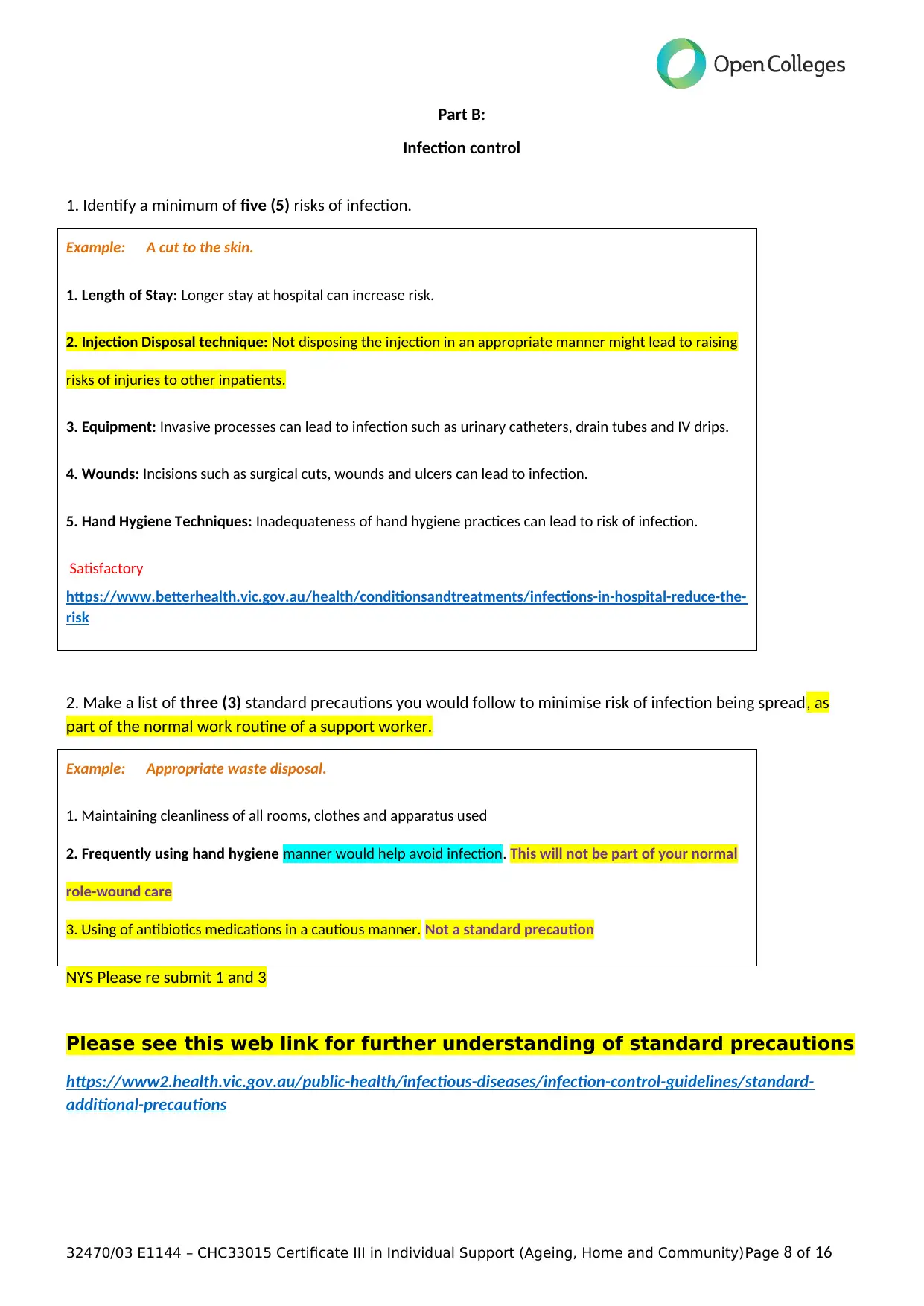
Part B:
Infection control
1. Identify a minimum of five (5) risks of infection.
Example: A cut to the skin.
1. Length of Stay: Longer stay at hospital can increase risk.
2. Injection Disposal technique: Not disposing the injection in an appropriate manner might lead to raising
risks of injuries to other inpatients.
3. Equipment: Invasive processes can lead to infection such as urinary catheters, drain tubes and IV drips.
4. Wounds: Incisions such as surgical cuts, wounds and ulcers can lead to infection.
5. Hand Hygiene Techniques: Inadequateness of hand hygiene practices can lead to risk of infection.
Satisfactory
https://www.betterhealth.vic.gov.au/health/conditionsandtreatments/infections-in-hospital-reduce-the-
risk
2. Make a list of three (3) standard precautions you would follow to minimise risk of infection being spread, as
part of the normal work routine of a support worker.
Example: Appropriate waste disposal.
1. Maintaining cleanliness of all rooms, clothes and apparatus used
2. Frequently using hand hygiene manner would help avoid infection. This will not be part of your normal
role-wound care
3. Using of antibiotics medications in a cautious manner. Not a standard precaution
NYS Please re submit 1 and 3
Please see this web link for further understanding of standard precautions
https://www2.health.vic.gov.au/public-health/infectious-diseases/infection-control-guidelines/standard-
additional-precautions
32470/03 E1144 – CHC33015 Certificate III in Individual Support (Ageing, Home and Community)Page 8 of 16
Infection control
1. Identify a minimum of five (5) risks of infection.
Example: A cut to the skin.
1. Length of Stay: Longer stay at hospital can increase risk.
2. Injection Disposal technique: Not disposing the injection in an appropriate manner might lead to raising
risks of injuries to other inpatients.
3. Equipment: Invasive processes can lead to infection such as urinary catheters, drain tubes and IV drips.
4. Wounds: Incisions such as surgical cuts, wounds and ulcers can lead to infection.
5. Hand Hygiene Techniques: Inadequateness of hand hygiene practices can lead to risk of infection.
Satisfactory
https://www.betterhealth.vic.gov.au/health/conditionsandtreatments/infections-in-hospital-reduce-the-
risk
2. Make a list of three (3) standard precautions you would follow to minimise risk of infection being spread, as
part of the normal work routine of a support worker.
Example: Appropriate waste disposal.
1. Maintaining cleanliness of all rooms, clothes and apparatus used
2. Frequently using hand hygiene manner would help avoid infection. This will not be part of your normal
role-wound care
3. Using of antibiotics medications in a cautious manner. Not a standard precaution
NYS Please re submit 1 and 3
Please see this web link for further understanding of standard precautions
https://www2.health.vic.gov.au/public-health/infectious-diseases/infection-control-guidelines/standard-
additional-precautions
32470/03 E1144 – CHC33015 Certificate III in Individual Support (Ageing, Home and Community)Page 8 of 16

32470/03 E1144 – CHC33015 Certificate III in Individual Support (Ageing, Home and Community)Page 9 of 16
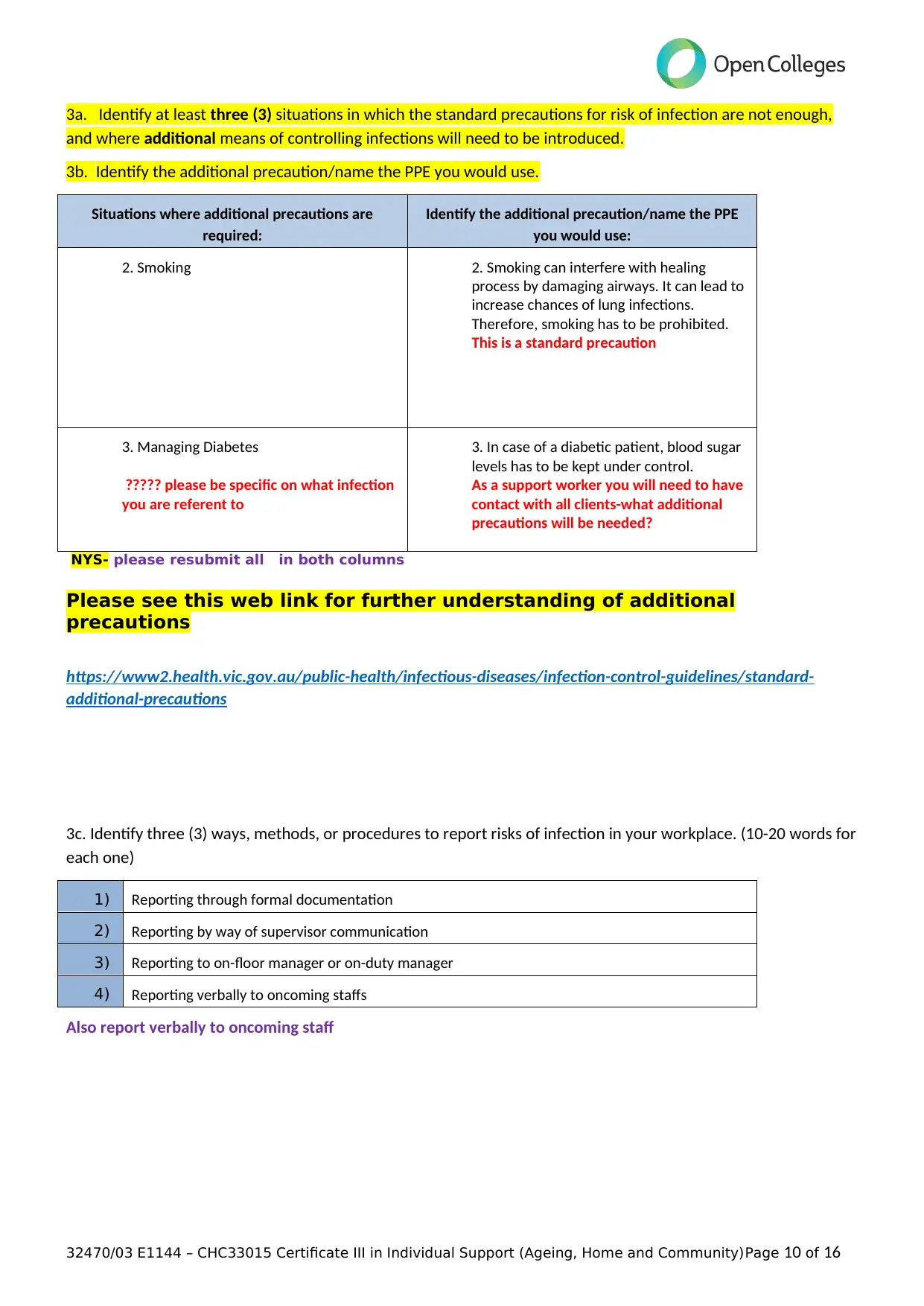
3a. Identify at least three (3) situations in which the standard precautions for risk of infection are not enough,
and where additional means of controlling infections will need to be introduced.
3b. Identify the additional precaution/name the PPE you would use.
Situations where additional precautions are
required:
Identify the additional precaution/name the PPE
you would use:
2. Smoking 2. Smoking can interfere with healing
process by damaging airways. It can lead to
increase chances of lung infections.
Therefore, smoking has to be prohibited.
This is a standard precaution
3. Managing Diabetes
????? please be specific on what infection
you are referent to
3. In case of a diabetic patient, blood sugar
levels has to be kept under control.
As a support worker you will need to have
contact with all clients-what additional
precautions will be needed?
NYS- please resubmit all in both columns
Please see this web link for further understanding of additional
precautions
https://www2.health.vic.gov.au/public-health/infectious-diseases/infection-control-guidelines/standard-
additional-precautions
3c. Identify three (3) ways, methods, or procedures to report risks of infection in your workplace. (10-20 words for
each one)
1) Reporting through formal documentation
2) Reporting by way of supervisor communication
3) Reporting to on-floor manager or on-duty manager
4) Reporting verbally to oncoming staffs
Also report verbally to oncoming staff
32470/03 E1144 – CHC33015 Certificate III in Individual Support (Ageing, Home and Community)Page 10 of 16
and where additional means of controlling infections will need to be introduced.
3b. Identify the additional precaution/name the PPE you would use.
Situations where additional precautions are
required:
Identify the additional precaution/name the PPE
you would use:
2. Smoking 2. Smoking can interfere with healing
process by damaging airways. It can lead to
increase chances of lung infections.
Therefore, smoking has to be prohibited.
This is a standard precaution
3. Managing Diabetes
????? please be specific on what infection
you are referent to
3. In case of a diabetic patient, blood sugar
levels has to be kept under control.
As a support worker you will need to have
contact with all clients-what additional
precautions will be needed?
NYS- please resubmit all in both columns
Please see this web link for further understanding of additional
precautions
https://www2.health.vic.gov.au/public-health/infectious-diseases/infection-control-guidelines/standard-
additional-precautions
3c. Identify three (3) ways, methods, or procedures to report risks of infection in your workplace. (10-20 words for
each one)
1) Reporting through formal documentation
2) Reporting by way of supervisor communication
3) Reporting to on-floor manager or on-duty manager
4) Reporting verbally to oncoming staffs
Also report verbally to oncoming staff
32470/03 E1144 – CHC33015 Certificate III in Individual Support (Ageing, Home and Community)Page 10 of 16
Secure Best Marks with AI Grader
Need help grading? Try our AI Grader for instant feedback on your assignments.
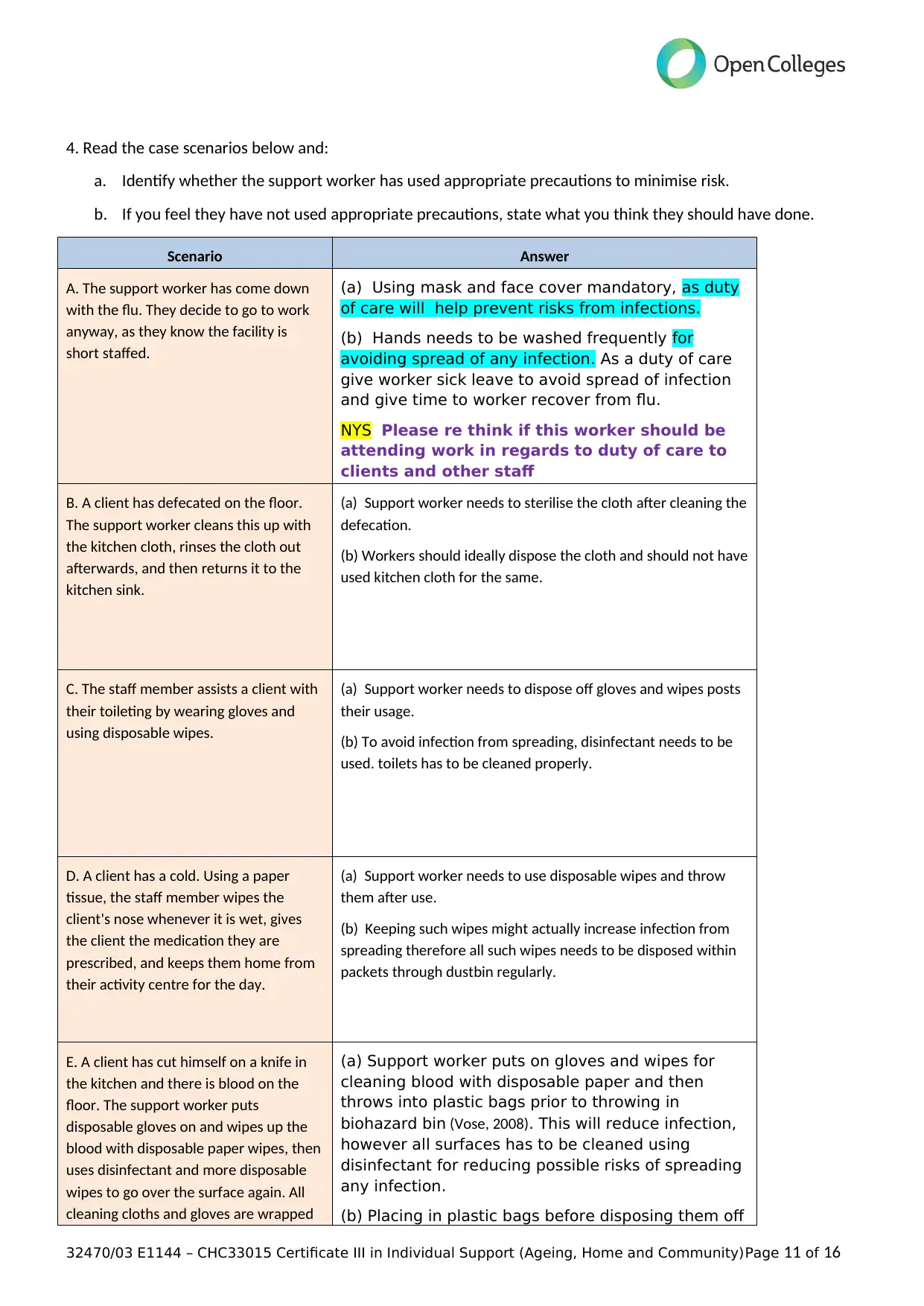
4. Read the case scenarios below and:
a. Identify whether the support worker has used appropriate precautions to minimise risk.
b. If you feel they have not used appropriate precautions, state what you think they should have done.
Scenario Answer
A. The support worker has come down
with the flu. They decide to go to work
anyway, as they know the facility is
short staffed.
(a) Using mask and face cover mandatory, as duty
of care will help prevent risks from infections.
(b) Hands needs to be washed frequently for
avoiding spread of any infection. As a duty of care
give worker sick leave to avoid spread of infection
and give time to worker recover from flu.
NYS Please re think if this worker should be
attending work in regards to duty of care to
clients and other staff
B. A client has defecated on the floor.
The support worker cleans this up with
the kitchen cloth, rinses the cloth out
afterwards, and then returns it to the
kitchen sink.
(a) Support worker needs to sterilise the cloth after cleaning the
defecation.
(b) Workers should ideally dispose the cloth and should not have
used kitchen cloth for the same.
C. The staff member assists a client with
their toileting by wearing gloves and
using disposable wipes.
(a) Support worker needs to dispose off gloves and wipes posts
their usage.
(b) To avoid infection from spreading, disinfectant needs to be
used. toilets has to be cleaned properly.
D. A client has a cold. Using a paper
tissue, the staff member wipes the
client's nose whenever it is wet, gives
the client the medication they are
prescribed, and keeps them home from
their activity centre for the day.
(a) Support worker needs to use disposable wipes and throw
them after use.
(b) Keeping such wipes might actually increase infection from
spreading therefore all such wipes needs to be disposed within
packets through dustbin regularly.
E. A client has cut himself on a knife in
the kitchen and there is blood on the
floor. The support worker puts
disposable gloves on and wipes up the
blood with disposable paper wipes, then
uses disinfectant and more disposable
wipes to go over the surface again. All
cleaning cloths and gloves are wrapped
(a) Support worker puts on gloves and wipes for
cleaning blood with disposable paper and then
throws into plastic bags prior to throwing in
biohazard bin (Vose, 2008). This will reduce infection,
however all surfaces has to be cleaned using
disinfectant for reducing possible risks of spreading
any infection.
(b) Placing in plastic bags before disposing them off
32470/03 E1144 – CHC33015 Certificate III in Individual Support (Ageing, Home and Community)Page 11 of 16
a. Identify whether the support worker has used appropriate precautions to minimise risk.
b. If you feel they have not used appropriate precautions, state what you think they should have done.
Scenario Answer
A. The support worker has come down
with the flu. They decide to go to work
anyway, as they know the facility is
short staffed.
(a) Using mask and face cover mandatory, as duty
of care will help prevent risks from infections.
(b) Hands needs to be washed frequently for
avoiding spread of any infection. As a duty of care
give worker sick leave to avoid spread of infection
and give time to worker recover from flu.
NYS Please re think if this worker should be
attending work in regards to duty of care to
clients and other staff
B. A client has defecated on the floor.
The support worker cleans this up with
the kitchen cloth, rinses the cloth out
afterwards, and then returns it to the
kitchen sink.
(a) Support worker needs to sterilise the cloth after cleaning the
defecation.
(b) Workers should ideally dispose the cloth and should not have
used kitchen cloth for the same.
C. The staff member assists a client with
their toileting by wearing gloves and
using disposable wipes.
(a) Support worker needs to dispose off gloves and wipes posts
their usage.
(b) To avoid infection from spreading, disinfectant needs to be
used. toilets has to be cleaned properly.
D. A client has a cold. Using a paper
tissue, the staff member wipes the
client's nose whenever it is wet, gives
the client the medication they are
prescribed, and keeps them home from
their activity centre for the day.
(a) Support worker needs to use disposable wipes and throw
them after use.
(b) Keeping such wipes might actually increase infection from
spreading therefore all such wipes needs to be disposed within
packets through dustbin regularly.
E. A client has cut himself on a knife in
the kitchen and there is blood on the
floor. The support worker puts
disposable gloves on and wipes up the
blood with disposable paper wipes, then
uses disinfectant and more disposable
wipes to go over the surface again. All
cleaning cloths and gloves are wrapped
(a) Support worker puts on gloves and wipes for
cleaning blood with disposable paper and then
throws into plastic bags prior to throwing in
biohazard bin (Vose, 2008). This will reduce infection,
however all surfaces has to be cleaned using
disinfectant for reducing possible risks of spreading
any infection.
(b) Placing in plastic bags before disposing them off
32470/03 E1144 – CHC33015 Certificate III in Individual Support (Ageing, Home and Community)Page 11 of 16
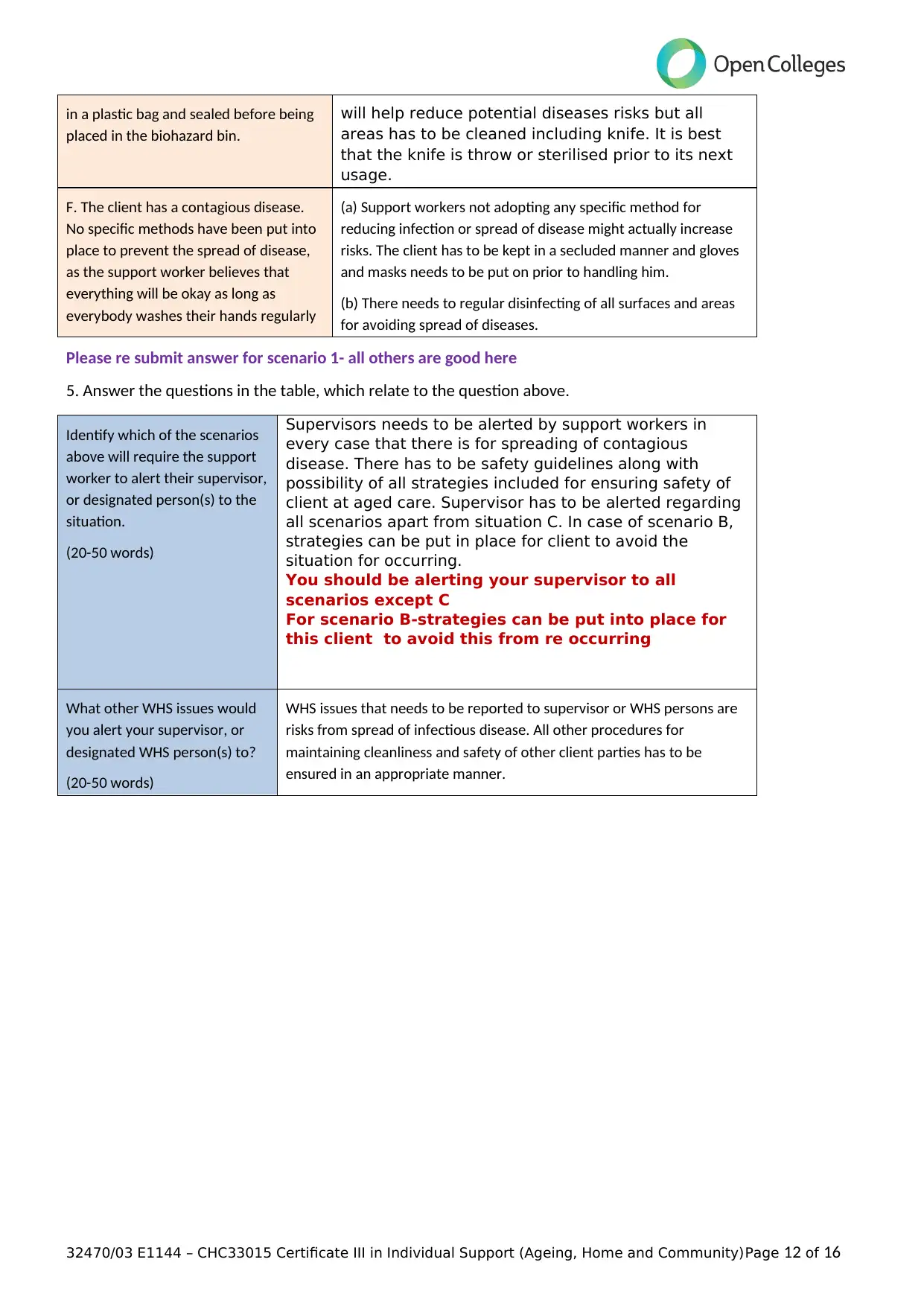
in a plastic bag and sealed before being
placed in the biohazard bin.
will help reduce potential diseases risks but all
areas has to be cleaned including knife. It is best
that the knife is throw or sterilised prior to its next
usage.
F. The client has a contagious disease.
No specific methods have been put into
place to prevent the spread of disease,
as the support worker believes that
everything will be okay as long as
everybody washes their hands regularly
(a) Support workers not adopting any specific method for
reducing infection or spread of disease might actually increase
risks. The client has to be kept in a secluded manner and gloves
and masks needs to be put on prior to handling him.
(b) There needs to regular disinfecting of all surfaces and areas
for avoiding spread of diseases.
Please re submit answer for scenario 1- all others are good here
5. Answer the questions in the table, which relate to the question above.
Identify which of the scenarios
above will require the support
worker to alert their supervisor,
or designated person(s) to the
situation.
(20-50 words)
Supervisors needs to be alerted by support workers in
every case that there is for spreading of contagious
disease. There has to be safety guidelines along with
possibility of all strategies included for ensuring safety of
client at aged care. Supervisor has to be alerted regarding
all scenarios apart from situation C. In case of scenario B,
strategies can be put in place for client to avoid the
situation for occurring.
You should be alerting your supervisor to all
scenarios except C
For scenario B-strategies can be put into place for
this client to avoid this from re occurring
What other WHS issues would
you alert your supervisor, or
designated WHS person(s) to?
(20-50 words)
WHS issues that needs to be reported to supervisor or WHS persons are
risks from spread of infectious disease. All other procedures for
maintaining cleanliness and safety of other client parties has to be
ensured in an appropriate manner.
32470/03 E1144 – CHC33015 Certificate III in Individual Support (Ageing, Home and Community)Page 12 of 16
placed in the biohazard bin.
will help reduce potential diseases risks but all
areas has to be cleaned including knife. It is best
that the knife is throw or sterilised prior to its next
usage.
F. The client has a contagious disease.
No specific methods have been put into
place to prevent the spread of disease,
as the support worker believes that
everything will be okay as long as
everybody washes their hands regularly
(a) Support workers not adopting any specific method for
reducing infection or spread of disease might actually increase
risks. The client has to be kept in a secluded manner and gloves
and masks needs to be put on prior to handling him.
(b) There needs to regular disinfecting of all surfaces and areas
for avoiding spread of diseases.
Please re submit answer for scenario 1- all others are good here
5. Answer the questions in the table, which relate to the question above.
Identify which of the scenarios
above will require the support
worker to alert their supervisor,
or designated person(s) to the
situation.
(20-50 words)
Supervisors needs to be alerted by support workers in
every case that there is for spreading of contagious
disease. There has to be safety guidelines along with
possibility of all strategies included for ensuring safety of
client at aged care. Supervisor has to be alerted regarding
all scenarios apart from situation C. In case of scenario B,
strategies can be put in place for client to avoid the
situation for occurring.
You should be alerting your supervisor to all
scenarios except C
For scenario B-strategies can be put into place for
this client to avoid this from re occurring
What other WHS issues would
you alert your supervisor, or
designated WHS person(s) to?
(20-50 words)
WHS issues that needs to be reported to supervisor or WHS persons are
risks from spread of infectious disease. All other procedures for
maintaining cleanliness and safety of other client parties has to be
ensured in an appropriate manner.
32470/03 E1144 – CHC33015 Certificate III in Individual Support (Ageing, Home and Community)Page 12 of 16
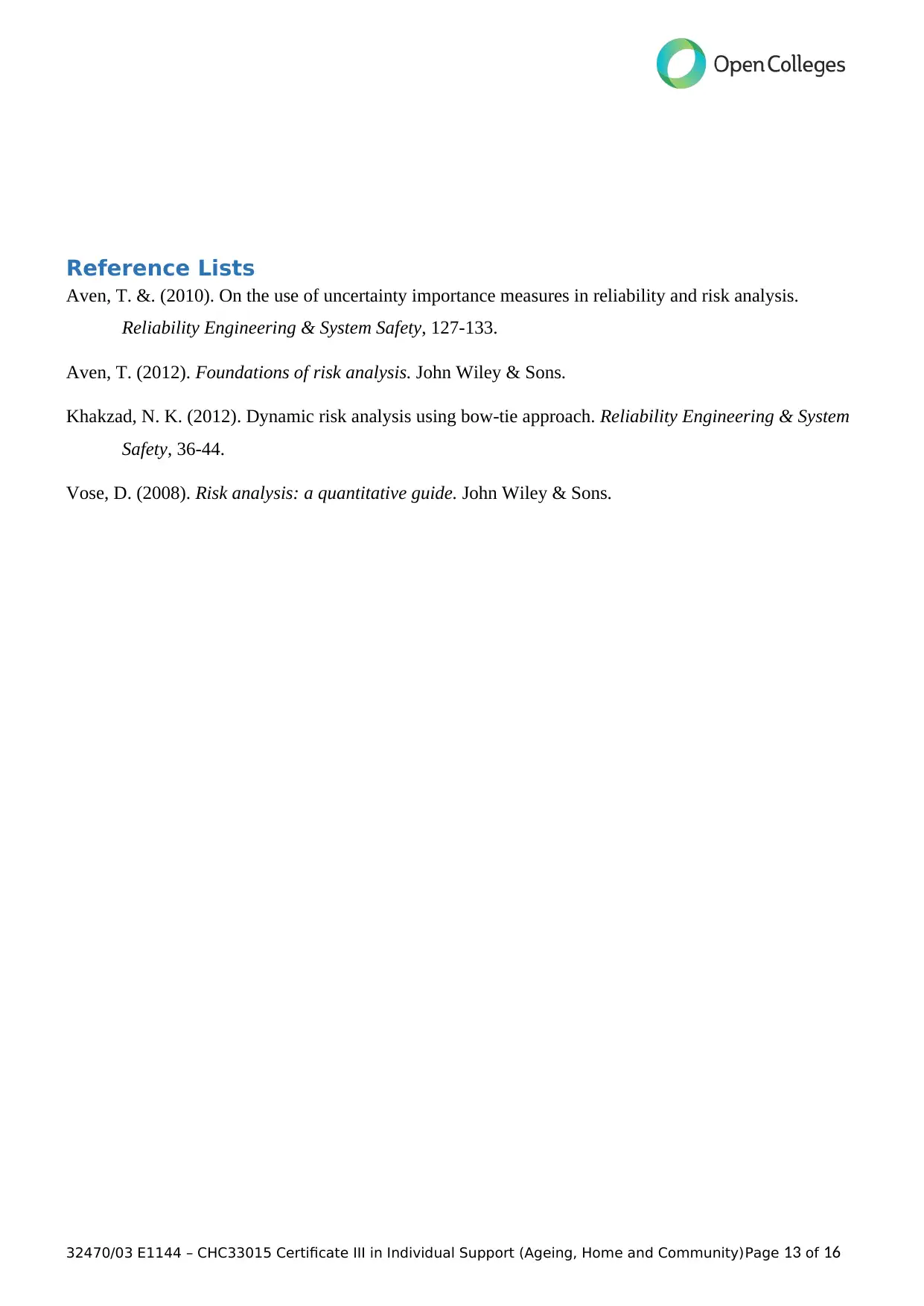
Reference Lists
Aven, T. &. (2010). On the use of uncertainty importance measures in reliability and risk analysis.
Reliability Engineering & System Safety, 127-133.
Aven, T. (2012). Foundations of risk analysis. John Wiley & Sons.
Khakzad, N. K. (2012). Dynamic risk analysis using bow-tie approach. Reliability Engineering & System
Safety, 36-44.
Vose, D. (2008). Risk analysis: a quantitative guide. John Wiley & Sons.
32470/03 E1144 – CHC33015 Certificate III in Individual Support (Ageing, Home and Community)Page 13 of 16
Aven, T. &. (2010). On the use of uncertainty importance measures in reliability and risk analysis.
Reliability Engineering & System Safety, 127-133.
Aven, T. (2012). Foundations of risk analysis. John Wiley & Sons.
Khakzad, N. K. (2012). Dynamic risk analysis using bow-tie approach. Reliability Engineering & System
Safety, 36-44.
Vose, D. (2008). Risk analysis: a quantitative guide. John Wiley & Sons.
32470/03 E1144 – CHC33015 Certificate III in Individual Support (Ageing, Home and Community)Page 13 of 16
Paraphrase This Document
Need a fresh take? Get an instant paraphrase of this document with our AI Paraphraser

32470/03 E1144 – CHC33015 Certificate III in Individual Support (Ageing, Home and Community)Page 14 of 16
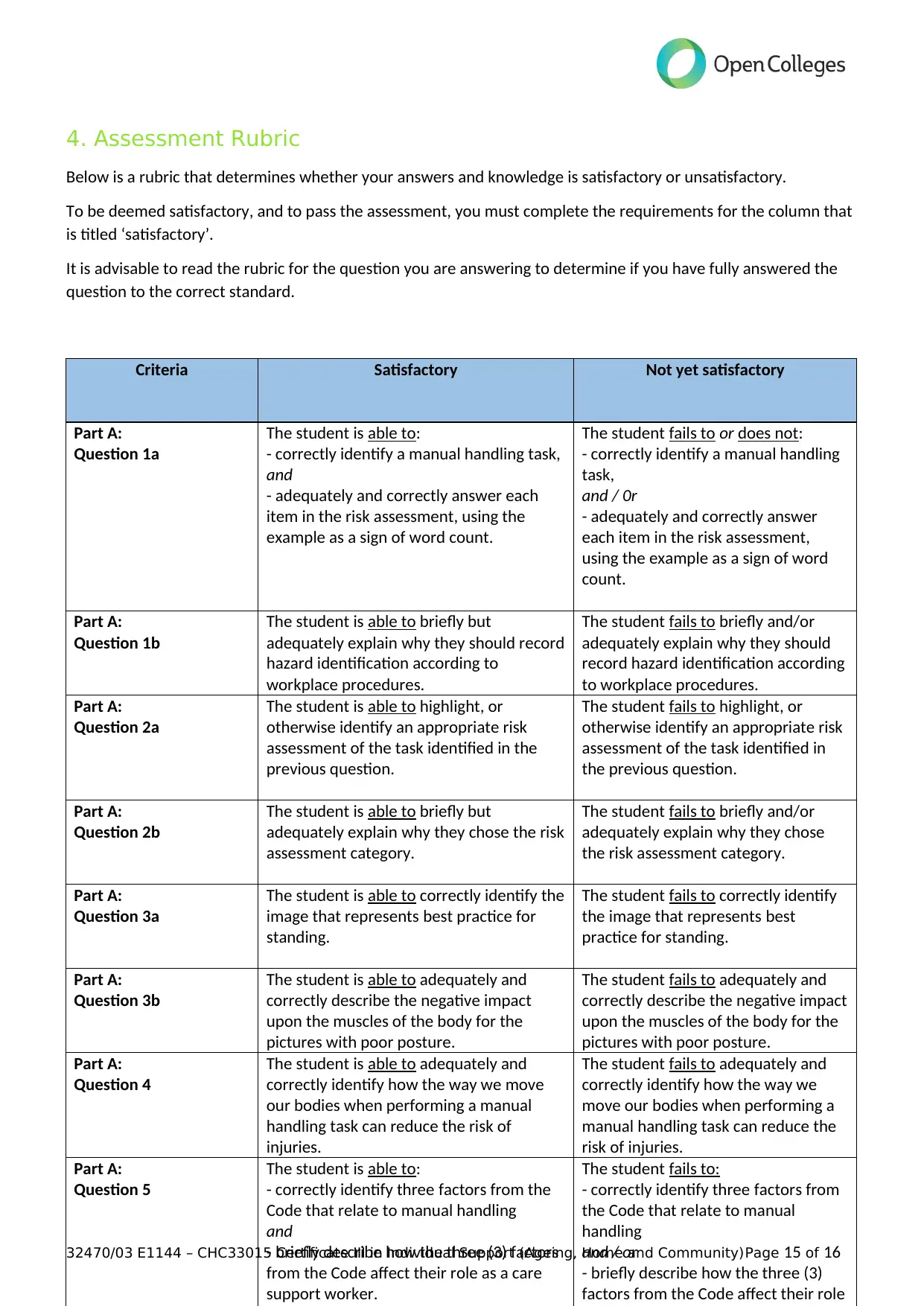
4. Assessment Rubric
Below is a rubric that determines whether your answers and knowledge is satisfactory or unsatisfactory.
To be deemed satisfactory, and to pass the assessment, you must complete the requirements for the column that
is titled ‘satisfactory’.
It is advisable to read the rubric for the question you are answering to determine if you have fully answered the
question to the correct standard.
32470/03 E1144 – CHC33015 Certificate III in Individual Support (Ageing, Home and Community)Page 15 of 16
Criteria Satisfactory Not yet satisfactory
Part A:
Question 1a
The student is able to:
- correctly identify a manual handling task,
and
- adequately and correctly answer each
item in the risk assessment, using the
example as a sign of word count.
The student fails to or does not:
- correctly identify a manual handling
task,
and / 0r
- adequately and correctly answer
each item in the risk assessment,
using the example as a sign of word
count.
Part A:
Question 1b
The student is able to briefly but
adequately explain why they should record
hazard identification according to
workplace procedures.
The student fails to briefly and/or
adequately explain why they should
record hazard identification according
to workplace procedures.
Part A:
Question 2a
The student is able to highlight, or
otherwise identify an appropriate risk
assessment of the task identified in the
previous question.
The student fails to highlight, or
otherwise identify an appropriate risk
assessment of the task identified in
the previous question.
Part A:
Question 2b
The student is able to briefly but
adequately explain why they chose the risk
assessment category.
The student fails to briefly and/or
adequately explain why they chose
the risk assessment category.
Part A:
Question 3a
The student is able to correctly identify the
image that represents best practice for
standing.
The student fails to correctly identify
the image that represents best
practice for standing.
Part A:
Question 3b
The student is able to adequately and
correctly describe the negative impact
upon the muscles of the body for the
pictures with poor posture.
The student fails to adequately and
correctly describe the negative impact
upon the muscles of the body for the
pictures with poor posture.
Part A:
Question 4
The student is able to adequately and
correctly identify how the way we move
our bodies when performing a manual
handling task can reduce the risk of
injuries.
The student fails to adequately and
correctly identify how the way we
move our bodies when performing a
manual handling task can reduce the
risk of injuries.
Part A:
Question 5
The student is able to:
- correctly identify three factors from the
Code that relate to manual handling
and
- briefly describe how the three (3) factors
from the Code affect their role as a care
support worker.
The student fails to:
- correctly identify three factors from
the Code that relate to manual
handling
and / or
- briefly describe how the three (3)
factors from the Code affect their role
Below is a rubric that determines whether your answers and knowledge is satisfactory or unsatisfactory.
To be deemed satisfactory, and to pass the assessment, you must complete the requirements for the column that
is titled ‘satisfactory’.
It is advisable to read the rubric for the question you are answering to determine if you have fully answered the
question to the correct standard.
32470/03 E1144 – CHC33015 Certificate III in Individual Support (Ageing, Home and Community)Page 15 of 16
Criteria Satisfactory Not yet satisfactory
Part A:
Question 1a
The student is able to:
- correctly identify a manual handling task,
and
- adequately and correctly answer each
item in the risk assessment, using the
example as a sign of word count.
The student fails to or does not:
- correctly identify a manual handling
task,
and / 0r
- adequately and correctly answer
each item in the risk assessment,
using the example as a sign of word
count.
Part A:
Question 1b
The student is able to briefly but
adequately explain why they should record
hazard identification according to
workplace procedures.
The student fails to briefly and/or
adequately explain why they should
record hazard identification according
to workplace procedures.
Part A:
Question 2a
The student is able to highlight, or
otherwise identify an appropriate risk
assessment of the task identified in the
previous question.
The student fails to highlight, or
otherwise identify an appropriate risk
assessment of the task identified in
the previous question.
Part A:
Question 2b
The student is able to briefly but
adequately explain why they chose the risk
assessment category.
The student fails to briefly and/or
adequately explain why they chose
the risk assessment category.
Part A:
Question 3a
The student is able to correctly identify the
image that represents best practice for
standing.
The student fails to correctly identify
the image that represents best
practice for standing.
Part A:
Question 3b
The student is able to adequately and
correctly describe the negative impact
upon the muscles of the body for the
pictures with poor posture.
The student fails to adequately and
correctly describe the negative impact
upon the muscles of the body for the
pictures with poor posture.
Part A:
Question 4
The student is able to adequately and
correctly identify how the way we move
our bodies when performing a manual
handling task can reduce the risk of
injuries.
The student fails to adequately and
correctly identify how the way we
move our bodies when performing a
manual handling task can reduce the
risk of injuries.
Part A:
Question 5
The student is able to:
- correctly identify three factors from the
Code that relate to manual handling
and
- briefly describe how the three (3) factors
from the Code affect their role as a care
support worker.
The student fails to:
- correctly identify three factors from
the Code that relate to manual
handling
and / or
- briefly describe how the three (3)
factors from the Code affect their role
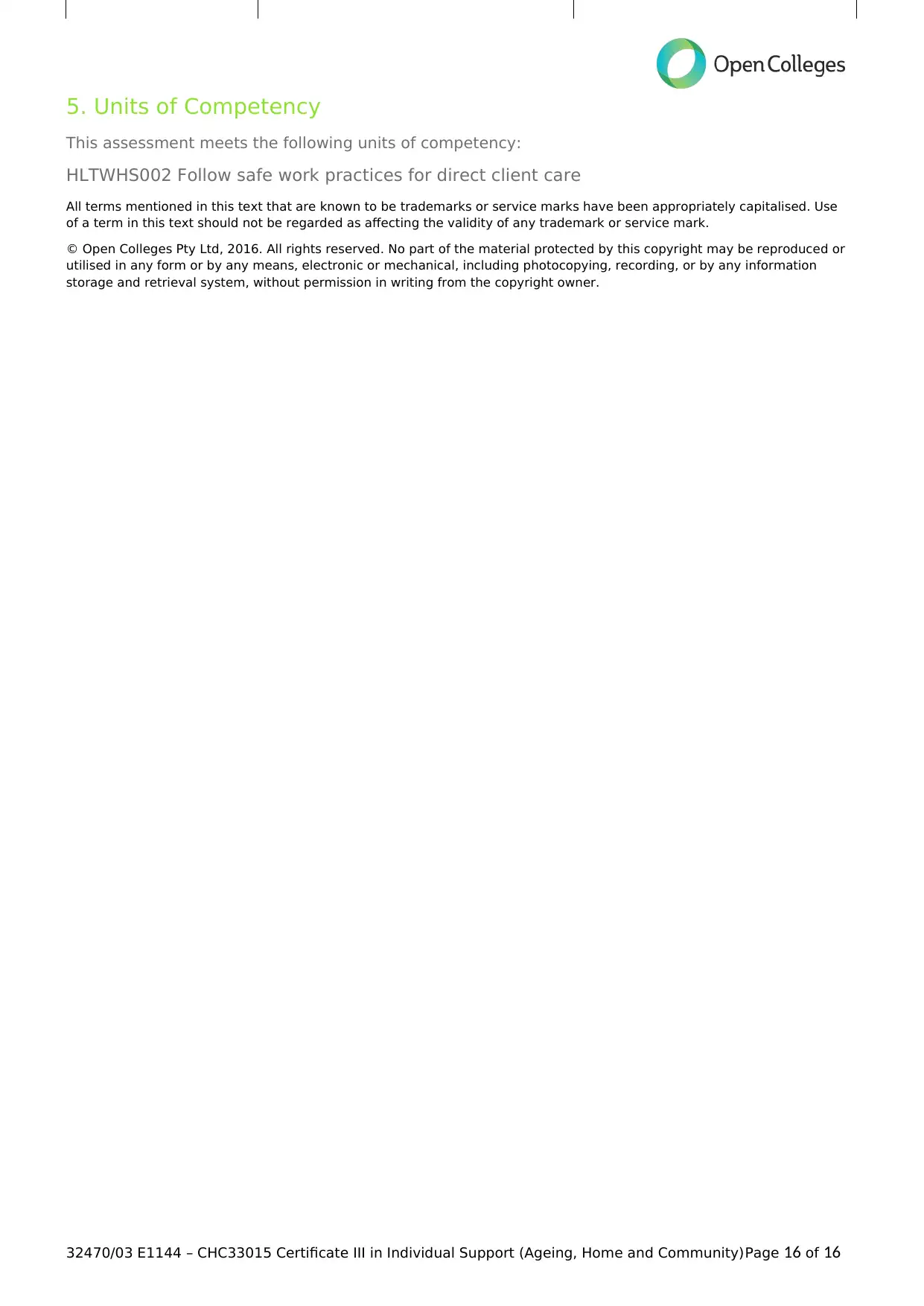
5. Units of Competency
This assessment meets the following units of competency:
HLTWHS002 Follow safe work practices for direct client care
All terms mentioned in this text that are known to be trademarks or service marks have been appropriately capitalised. Use
of a term in this text should not be regarded as affecting the validity of any trademark or service mark.
© Open Colleges Pty Ltd, 2016. All rights reserved. No part of the material protected by this copyright may be reproduced or
utilised in any form or by any means, electronic or mechanical, including photocopying, recording, or by any information
storage and retrieval system, without permission in writing from the copyright owner.
32470/03 E1144 – CHC33015 Certificate III in Individual Support (Ageing, Home and Community)Page 16 of 16
This assessment meets the following units of competency:
HLTWHS002 Follow safe work practices for direct client care
All terms mentioned in this text that are known to be trademarks or service marks have been appropriately capitalised. Use
of a term in this text should not be regarded as affecting the validity of any trademark or service mark.
© Open Colleges Pty Ltd, 2016. All rights reserved. No part of the material protected by this copyright may be reproduced or
utilised in any form or by any means, electronic or mechanical, including photocopying, recording, or by any information
storage and retrieval system, without permission in writing from the copyright owner.
32470/03 E1144 – CHC33015 Certificate III in Individual Support (Ageing, Home and Community)Page 16 of 16
1 out of 16
Related Documents
Your All-in-One AI-Powered Toolkit for Academic Success.
+13062052269
info@desklib.com
Available 24*7 on WhatsApp / Email
![[object Object]](/_next/static/media/star-bottom.7253800d.svg)
Unlock your academic potential
© 2024 | Zucol Services PVT LTD | All rights reserved.





